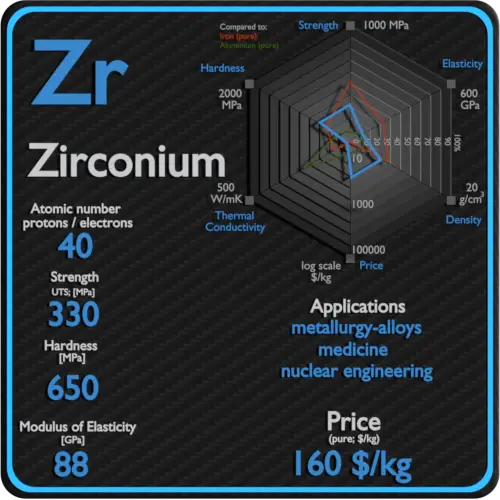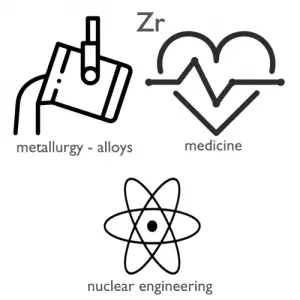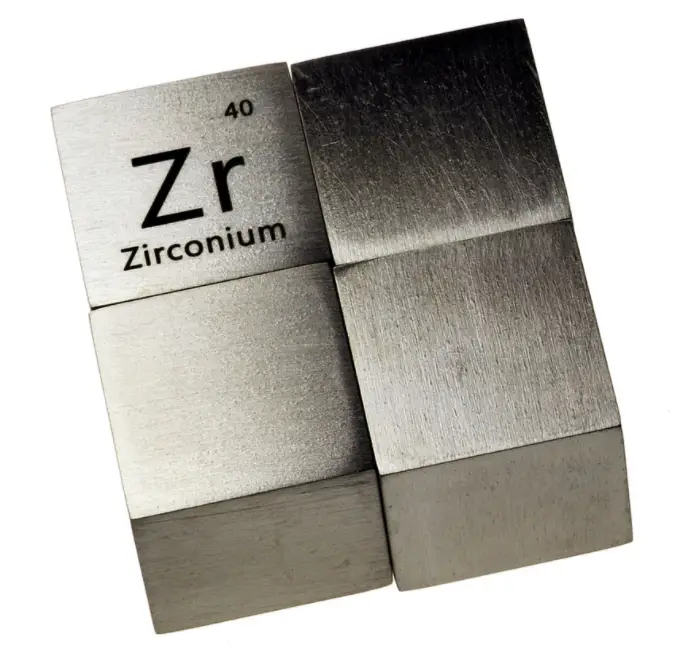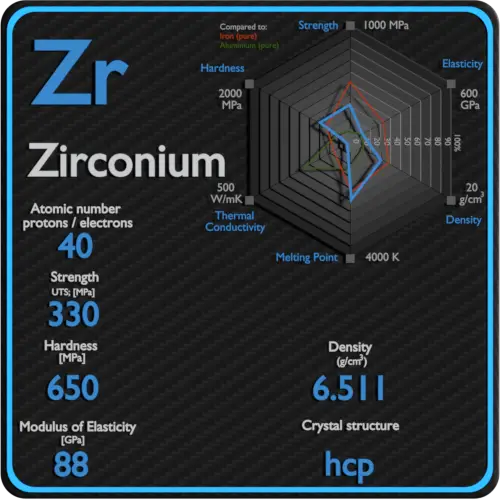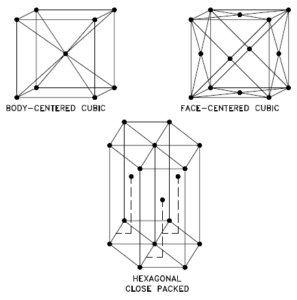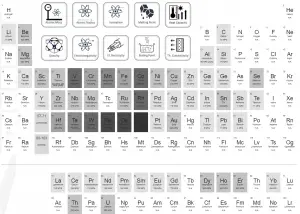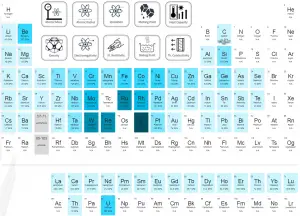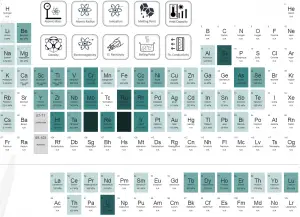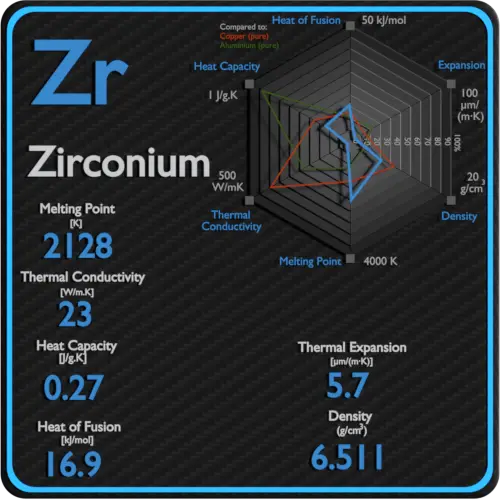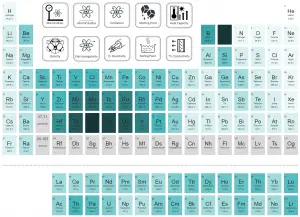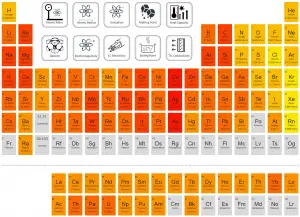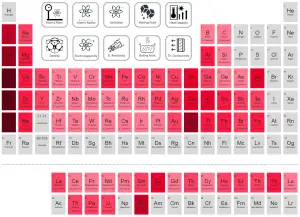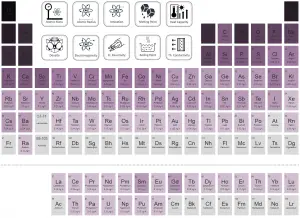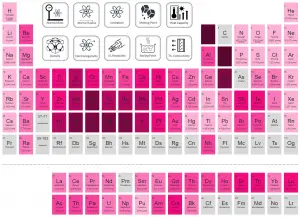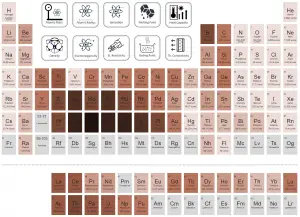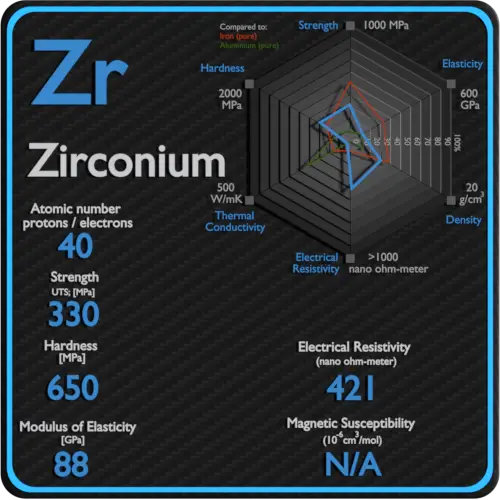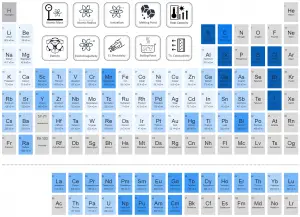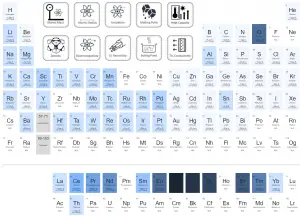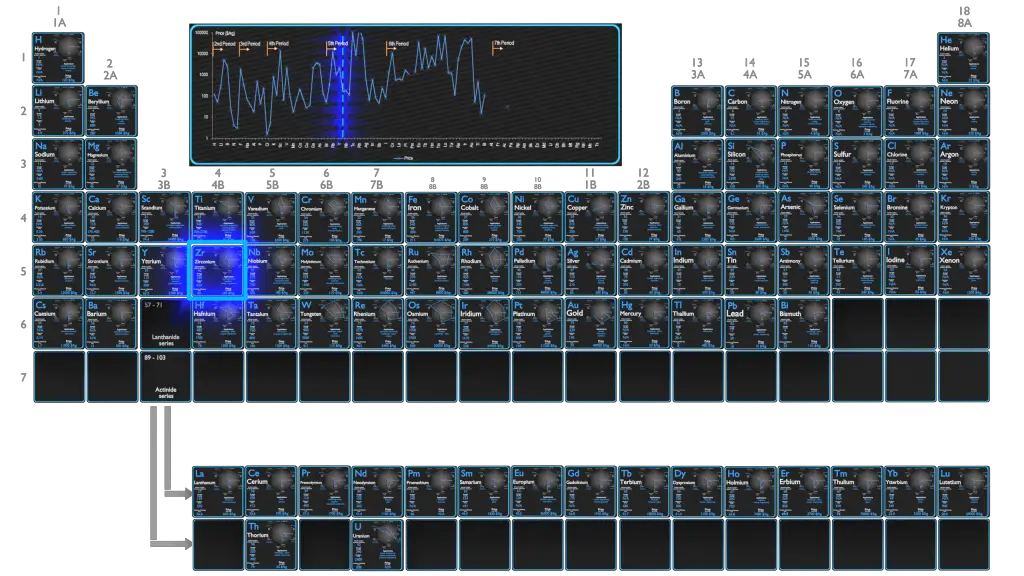About Zirconium
Zirconium is a lustrous, grey-white, strong transition metal that resembles hafnium and, to a lesser extent, titanium. Zirconium is mainly used as a refractory and opacifier, although small amounts are used as an alloying agent for its strong resistance to corrosion. Zirconium is widely used as a cladding for nuclear reactor fuels. The desired properties of these alloys are a low neutron-capture cross-section and resistance to corrosion under normal service conditions.
Summary
| Element | Zirconium |
| Atomic number | 40 |
| Element category | Transition Metal |
| Phase at STP | Solid |
| Density | 6.511 g/cm3 |
| Ultimate Tensile Strength | 330 MPa |
| Yield Strength | 230 MPa |
| Young’s Modulus of Elasticity | 88 GPa |
| Mohs Scale | 5 |
| Brinell Hardness | 650 MPa |
| Vickers Hardness | 900 MPa |
| Melting Point | 1855 °C |
| Boiling Point | 4377 °C |
| Thermal Conductivity | 22.7 W/mK |
| Thermal Expansion Coefficient | 5.7 µm/mK |
| Specific Heat | 0.27 J/g K |
| Heat of Fusion | 16.9 kJ/mol |
| Heat of Vaporization | 591 kJ/mol |
| Electrical resistivity [nanoOhm meter] | 421 |
| Magnetic Susceptibility | N/A |
Applications of Zirconium
Most zircon is used directly in high-temperature applications. This material is refractory, hard, and resistant to chemical attack. Because of these properties, zircon finds many applications, few of which are highly publicized. Its main use is as an opacifier, conferring a white, opaque appearance to ceramic materials. Zirconium and its alloys are widely used as a cladding for nuclear reactor fuels. Zirconium alloyed with niobium or tin has excellent corrosion properties. The high corrosion resistance of zirconium alloys results from the natural formation of a dense stable oxide on the surface of the metal. This film is self healing, it continues to grow slowly at temperatures up to approximately 550 °C (1020 °F), and it remains tightly adherent. The desired property of these alloys is also a low neutron-capture cross-section. The disadvantages of zirconium are low strength properties and low heat resistance, which can be eliminated, for example, by alloying with niobium.
Production and Price of Zirconium
Raw materials prices change daily. They are primarily driven by supply, demand and energy prices. In 2019, prices of pure Zirconium were at around 160 $/kg.
Approximately 900,000 tonnes of zirconium ores were mined in 1995, mostly as zircon. The production of zirconium metal requires special techniques due to the particular chemical properties of zirconium. Most Zr metal is produced from zircon (ZrSiO4) by the reduction of the zirconium chloride with magnesium metal in the Kroll process. The key feature of the Kroll process is reduction of zirconium chloride to metallic zirconium by magnesium. Commercial non-nuclear grade zirconium typically contains 1–5% of hafnium, whose neutron absorption cross-section is 600x that of zirconium. Hafnium must therefore be almost entirely removed (reduced to < 0.02% of the alloy) for reactor applications. In terms of cost, these alloys are also often the materials of choice for heat exchangers, and piping systems for the chemical-processing and nuclear industries. Zirconium is a by-product of the mining and processing of the titanium minerals, as well as tin mining. From 2003 to 2007, while prices for the mineral zircon steadily increased from $360 to $840 per tonne, the price for unwrought zirconium metal decreased from $39,900 to $22,700 per ton. Zirconium metal is much more expensive than zircon because the reduction processes are costly. All costs significantly vary with certain purity.
Source: www.luciteria.com
Mechanical Properties of Zirconium
Strength of Zirconium
In mechanics of materials, the strength of a material is its ability to withstand an applied load without failure or plastic deformation. Strength of materials basically considers the relationship between the external loads applied to a material and the resulting deformation or change in material dimensions. In designing structures and machines, it is important to consider these factors, in order that the material selected will have adequate strength to resist applied loads or forces and retain its original shape. Strength of a material is its ability to withstand this applied load without failure or plastic deformation.
For tensile stress, the capacity of a material or structure to withstand loads tending to elongate is known as ultimate tensile strength (UTS). Yield strength or yield stress is the material property defined as the stress at which a material begins to deform plastically whereas yield point is the point where nonlinear (elastic + plastic) deformation begins.
See also: Strength of Materials
Ultimate Tensile Strength of Zirconium
Ultimate tensile strength of Zirconium is 330 MPa.
Yield Strength of Zirconium
Yield strength of Zirconium is 230 MPa.
Modulus of Elasticity of Zirconium
The Young’s modulus of elasticity of Zirconium is 230 MPa.
Hardness of Zirconium
In materials science, hardness is the ability to withstand surface indentation (localized plastic deformation) and scratching. Brinell hardness test is one of indentation hardness tests, that has been developed for hardness testing. In Brinell tests, a hard, spherical indenter is forced under a specific load into the surface of the metal to be tested.
Brinell hardness of Zirconium is approximately 650 MPa.
The Vickers hardness test method was developed by Robert L. Smith and George E. Sandland at Vickers Ltd as an alternative to the Brinell method to measure the hardness of materials. The Vickers hardness test method can be also used as a microhardness test method, which is mostly used for small parts, thin sections, or case depth work.
Vickers hardness of Zirconium is approximately 900 MPa.
Scratch hardness is the measure of how resistant a sample is to permanent plastic deformation due to friction from a sharp object. The most common scale for this qualitative test is Mohs scale, which is used in mineralogy. The Mohs scale of mineral hardness is based on the ability of one natural sample of mineral to scratch another mineral visibly.
Zirconium is has a hardness of approximately 5.
See also: Hardness of Materials
Zirconium – Crystal Structure
A possible crystal structure of Zirconium is hexagonal close-packed structure.
In metals, and in many other solids, the atoms are arranged in regular arrays called crystals. A crystal lattice is a repeating pattern of mathematical points that extends throughout space. The forces of chemical bonding causes this repetition. It is this repeated pattern which control properties like strength, ductility, density, conductivity (property of conducting or transmitting heat, electricity, etc.), and shape. There are 14 general types of such patterns known as Bravais lattices.
See also: Crystal Structure of Materials
Crystal Structure of Zirconium
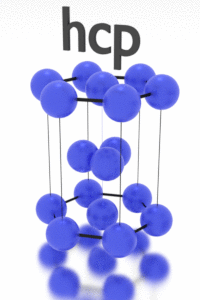
Thermal Properties of Zirconium
Zirconium – Melting Point and Boiling Point
Melting point of Zirconium is 1855°C.
Boiling point of Zirconium is 4377°C.
Note that, these points are associated with the standard atmospheric pressure.
Zirconium – Thermal Conductivity
Thermal conductivity of Zirconium is 22.7 W/(m·K).
The heat transfer characteristics of a solid material are measured by a property called the thermal conductivity, k (or λ), measured in W/m.K. It is a measure of a substance’s ability to transfer heat through a material by conduction. Note that Fourier’s law applies for all matter, regardless of its state (solid, liquid, or gas), therefore, it is also defined for liquids and gases.
Coefficient of Thermal Expansion of Zirconium
Linear thermal expansion coefficient of Zirconium is 5.7 µm/(m·K)
Thermal expansion is generally the tendency of matter to change its dimensions in response to a change in temperature. It is usually expressed as a fractional change in length or volume per unit temperature change.
Zirconium – Specific Heat, Latent Heat of Fusion, Latent Heat of Vaporization
Specific heat of Zirconium is 0.27 J/g K.
Heat capacity is an extensive property of matter, meaning it is proportional to the size of the system. Heat capacity C has the unit of energy per degree or energy per kelvin. When expressing the same phenomenon as an intensive property, the heat capacity is divided by the amount of substance, mass, or volume, thus the quantity is independent of the size or extent of the sample.
Latent Heat of Fusion of Zirconium is 16.9 kJ/mol.
Latent Heat of Vaporization of Zirconium is 591 kJ/mol.
Latent heat is the amount of heat added to or removed from a substance to produce a change in phase. This energy breaks down the intermolecular attractive forces, and also must provide the energy necessary to expand the gas (the pΔV work). When latent heat is added, no temperature change occurs. The enthalpy of vaporization is a function of the pressure at which that transformation takes place.
Zirconium – Electrical Resistivity – Magnetic Susceptibility
Electrical property refers to the response of a material to an applied electric field. One of the principal characteristics of materials is their ability (or lack of ability) to conduct electrical current. Indeed, materials are classified by this property, that is, they are divided into conductors, semiconductors, and nonconductors.
See also: Electrical Properties
Magnetic property refers to the response of a material to an applied magnetic field. The macroscopic magnetic properties of a material are a consequence of interactions between an external magnetic field and the magnetic dipole moments of the constituent atoms. Different materials react to the application of magnetic field differently.
See also: Magnetic Properties
Electrical Resistivity of Zirconium
Electrical resistivity of Zirconium is 421 nΩ⋅m.
Electrical conductivity and its converse, electrical resistivity, is a fundamental property of a material that quantifies how Zirconium conducts the flow of electric current. Electrical conductivity or specific conductance is the reciprocal of electrical resistivity.
Magnetic Susceptibility of Zirconium
Magnetic susceptibility of Zirconium is N/A.
In electromagnetism, magnetic susceptibility is the measure of the magnetization of a substance. Magnetic susceptibility is a dimensionless proportionality factor that indicates the degree of magnetization of Zirconium in response to an applied magnetic field.
